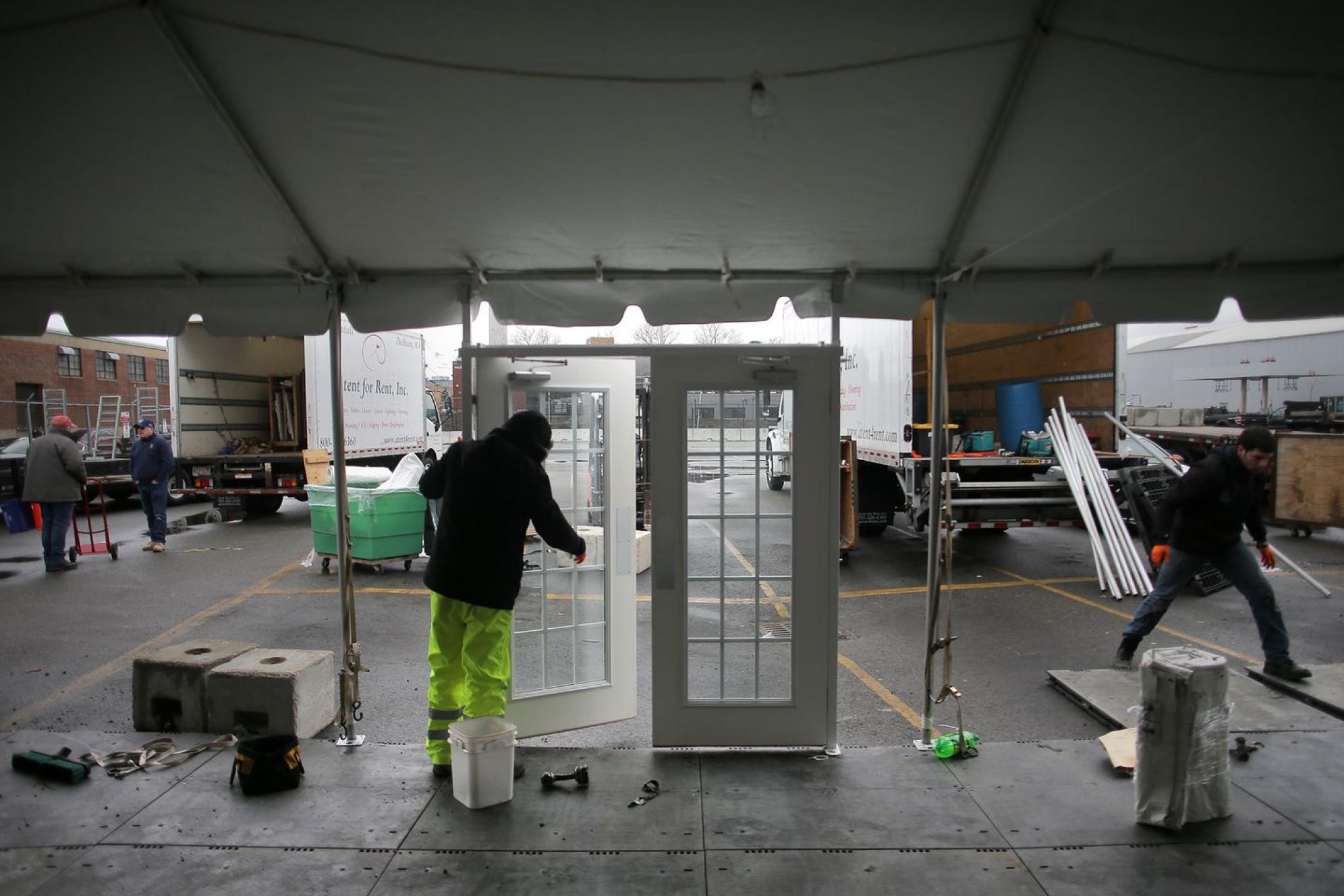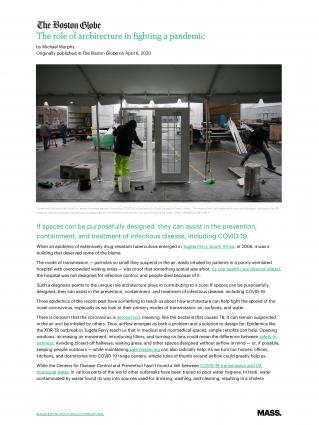The role of architecture in fighting a pandemic

The role of architecture in fighting a pandemic
by Michael Murphy
Originally published in The Boston Globe on April 6, 2020
If spaces can be purposefully designed, they can assist in the prevention, containment, and treatment of infectious disease, including COVID-19.
When an epidemic of extensively drug-resistant tuberculosis emerged in Tugela Ferry, South Africa, in 2006, it was a building that deserved some of the blame.
The mode of transmission — particles so small they suspend in the air, easily inhaled by patients in a poorly ventilated hospital with overcrowded waiting areas — was proof that something spatial was afoot. As one health care director stated, the hospital was not designed for infection control, and people died because of it.
Such a diagnosis points to the unique role architecture plays in contributing to a cure: If spaces can be purposefully designed, they can assist in the prevention, containment, and treatment of infectious disease, including COVID-19.
Three epidemics of the recent past have something to teach us about how architecture can help fight the spread of the novel coronavirus, especially as we look at their primary modes of transmission: air, surfaces, and water.
There is concern that the coronavirus is aerosolized, meaning, like the bacteria that causes TB, it can remain suspended in the air and be inhaled by others. Thus, airflow emerges as both a problem and a solution to design for. Epidemics like the XDR-TB outbreak in Tugela Ferry teach us that in medical and nonmedical spaces, simple retrofits can help. Opening windows, increasing air movement, introducing filters, and turning on fans could mean the difference between safety or sickness. Avoiding closed-off hallways, waiting areas, and other spaces designed without airflow in mind — or, if possible, keeping people outdoors — while maintaining safe distancing can also radically help. As we turn our homes, offices, kitchens, and dormitories into COVID-19 triage centers, simple rules of thumb around airflow could greatly help us.
While the Centers for Disease Control and Prevention hasn’t found a link between COVID-19 transmission and US municipal water, in various parts of the world other outbreaks have been traced to poor water hygiene. In Haiti, water contaminated by waste found its way into sources used for drinking, washing, and cleaning, resulting in a cholera outbreak in 2010. Emergency relief tents — while essential to meet demands for sick patients — continued to dump contaminated waste into the groundwater, making an emergency disaster into a permanent one.
In Port-au-Prince, doctors and architects worked together to build a new, permanent local facility that cared for patients, safely treated wastewater and hazardous materials, and provided potable water for the community. The solution leveraged relief dollars meant for tents and used them to build a center that managed waste, which helped aid the crisis and the recovery. We need designers on the ground to question the long-term implications of the spatial decisions we are making now to help prepare us to fight the next epidemic. We will have the same urgent needs in our relief for COVID-19.
In 2014, Ebola presented another spatial problem: a highly contagious virus that could survive on surfaces for nearly two weeks. Though stricter infection protocols and new health-worker safety measures were the primary strategies, architects played a role by renovating isolation units, creating innovative ventilation strategies, and designing pathogen-resistant surfaces that helped to keep the disease from spreading.
While typical infection-control protocols in hospitals have advocated for years to make every surface antimicrobial and to reduce the porosity of fabrics to prevent the spread of pathogens, in this case, porosity could be our ally. Studies are showing that coronavirus is more stable on plastic and steel (up to three days) than on porous fabrics like cotton, leather, and even cardboard (less than 24 hours). Designers are needed to question guidelines we have made for previous diseases in the face of new ones that may have different properties.
In each of these previous epidemics, space mattered. Buildings played an outsized role in the spread of infection — and redesign efforts played a key role in stemming the tide of a pandemic. Whether it’s providing ample, clean airflow to decrease the presence of contagion, building effective systems to separate waste from water, or designing spaces conducive to infection control, architecture can and should do its part to fight pandemics.
As the world continues to grapple with the coronavirus outbreak, never before in modern times have we needed more hands on deck, and from across all disciplines. When it came to Ebola, infectious disease specialists and scientists open-sourced their work in the interest of public welfare, forgoing the academic norm of holding data close to the vest. This type of collaboration was vital to turning the tide on one of the world’s most virulent pathogens and is a prescient sign of what will be required to respond to the current crisis.
Architects and designers stand at the ready to do their part. We can see the results of an all-hands-on-deck mentality with the temporary medical clinic established outside of Southampton Street Shelter in the South End, where nonprofit, government, design, and construction organizations all came together to design, build, and run a pop-up clinic in less than a week.
Our present-day situation marks a moment that will surely change the way we consider designing and building the spaces we need in the future. Architecture has been relegated as a passive backdrop, but if it is deployed as an active agent in the fight against the coronavirus pandemic, we can recapture trust over our public spaces and solve problems. The spatial choices we make today, during this emergency, might make or break our ability to survive both this crisis and the next one.
Michael Murphy is the founding principal and executive director of MASS Design Group, an architecture and design collective.

